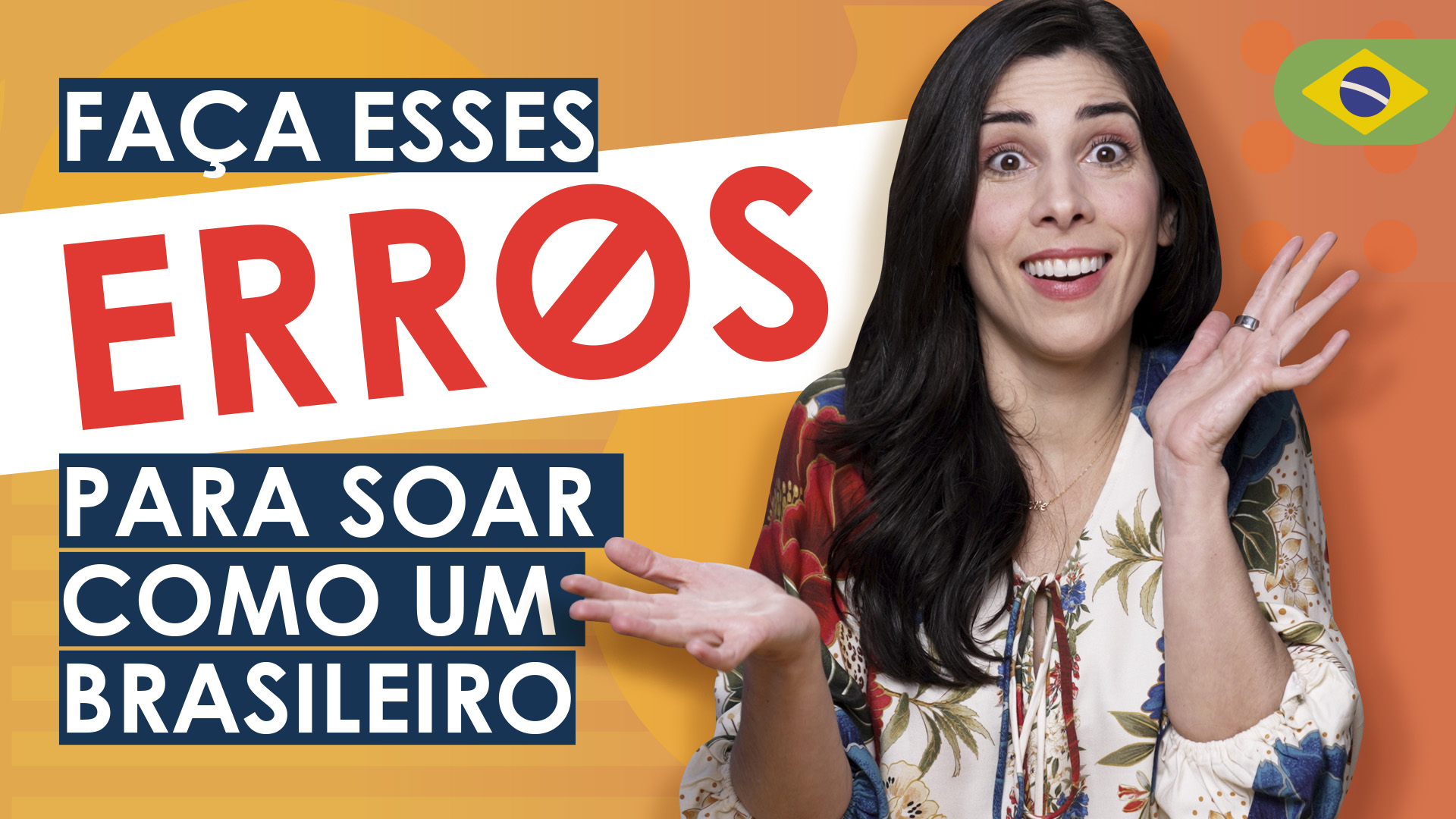Olá, queridos alunos! (Hello, dear students!)
“Talvez eu vou” or “talvez eu vá” (I might go)? Which one is correct?
The correct form is “talvez eu vá” (I might go). With the word “talvez” (maybe), we must use the subjuntivo (subjunctive mood).
In this lesson, I will explain everything you need to know about the three main tenses of the subjunctive mood.
This lesson consists of a video and a PDF with exercises for you to practice what you are about to learn. To make the most of what this lesson has to offer, fill out the form below to download your worksheet.
The Subjunctive Mood
Using the modo subjuntivo (subjunctive mood) correctly is challenging for most students because the rules are not very clear. Even native Brazilian speakers struggle with this topic.
I have a golden tip for you: instead of trying to make sense of all the rules, focus on the trigger words for the subjuntivo and the specific sentence structures that are used with each verb tense.
For example, whenever you use the word talvez (maybe), you must use the subjuntivo.
Talvez eu vá ao Brasil em maio. (Maybe I’ll go to Brazil in May.)
Whenever you use the structure “one person wants another person to do something,” you must use the subjuntivo.
Maria quer que João faça o almoço. (Maria wants João to make lunch.)
I’ll give you a list of trigger words and the most common sentence structures used in each of the three main tenses of the subjuntivo (subjunctive mood). Let’s start with the present subjunctive.
Presente do Subjuntivo
The presente do subjuntivo is used to express hypothesis, doubt, desire, uncertainty, or possibility. It can refer to the present or future and is often used in subordinate clauses.
For example:
Eu espero que você faça uma boa viagem. (I hope you have a good trip.)
Você quer que eu vá ao supermercado? (Do you want me to go to the supermarket?)
In both examples, notice the use of the conjunction “que” (that) to connect the two sentences. Almost always, the present subjunctive is introduced by “que”.
Also, notice that the subjects in these sentences are different:
Eu espero que você faça uma boa viagem. (I hope you have a good trip.)
Você quer que eu vá ao supermercado? (Do you want me to go to the supermarket?)
The presente do subjuntivo is often introduced by expressions that indicate desire, order, doubt, or emotion. Here are some common expressions (trigger words/ phrases):
- Espero que… (I hope that…)
- Quero que… (I want that…)
- Duvido que… (I doubt that…)
- É importante que… (It’s important that…)
- Espero que… (I hope that…)
- Quero que… (I want that…)
- Duvido que… (I doubt that…)
- É importante que… (It’s important that…)
- Tomara que… (I hope that…)
- Desejo que… (I wish that…)
- Prefiro que… (I prefer that…)
- Estou feliz que… (I’m glad that…)
- Lamento que… (I’m sorry that…)
- É preciso que… (It’s necessary that…)
- É provável que… (It’s likely that…)
- É possível que… (It’s possible that…)
Whenever you use these expressions, you know you need to use the subjunctive mood.
How regular verbs are conjugated in the presente do subjuntivo:
For verbs ending in AR, such as gostar (to like):
Espero que eu goste do filme. (I hope I like the movie.)
Espero que você goste do filme. (I hope you like the movie.)
Espero que nós gostemos do filme. (I hope we like the movie.)
Espero que eles gostem do filme. (I hope they like the movie.)
For verbs ending in ER, such as comer (to eat):
Talvez eu coma salada hoje. (Maybe I’ll eat a salad today.)
Talvez ele coma salada hoje. (Maybe he’ll eat a salad today.)
Talvez nós comamos salada hoje. (Maybe we’ll eat a salad today.)
Talvez eles comam salada hoje. (Maybe they’ll eat a salad today.)
For verbs ending in IR, such as assistir (to watch):
Ele quer que eu assista ao jogo. (He wants me to watch the game.)
Ele quer que você assista ao jogo. (He wants you to watch the game.)
Ele quer que nós assistamos ao jogo. (He wants us to watch the game.)
Ele quer que eles assistam ao jogo. (He wants them to watch the game.)
Imperfeito do Subjuntivo
Like the present subjunctive, the imperfeito do subjuntivo is used to express hypothesis, wishes, uncertainty, or possibility. It is also commonly used in subordinate clauses.
For example:
Se eu pudesse, eu viajaria pelo mundo. (If I could, I would travel the world.)
Se eu tivesse mais tempo, eu leria mais. (If I had more time, I would read more.)
Note the use of the conjunction “se” (if) to indicate a condition. Also notice the use of the futuro do pretérito (conditional tense) in these sentences: viajaria (would travel) and leria (would read).
How regular verbs are conjugated in the imperfeito do subjuntivo:
For verbs ending in AR, such as ganhar (to win):
Se eu ganhasse na loteria, eu viajaria mais. (If I won the lottery, I would travel more.)
Se você ganhasse na loteria, você viajaria mais. (If you won the lottery, you would travel more.)
Se nós ganhássemos na loteria, nós viajaríamos mais. (If we won the lottery, we would travel more.)
Se eles ganhassem na loteria, eles viajariam mais. (If they won the lottery, they would travel more.)
For verbs ending in ER, such as correr (to run):
Se eu corresse todos os dias, eu ficaria em forma. (If I ran every day, I would be in shape.)
Se você corresse todos os dias, você ficaria em forma. (If you ran every day, you would be in shape.)
Se nós corrêssemos todos os dias, nós ficaríamos em forma. (If we ran every day, we would be in shape.)
Se eles corressem todos os dias, eles ficariam em forma. (If they ran every day, they would be in shape.)
For verbs ending in IR, such as assistir (to watch):
Se eu assistisse ao jornal, eu saberia das novidades. (If I watched the news, I would know what’s happening.)
Se você assistisse ao jornal, você saberia das novidades. (If you watched the news, you would know what’s happening.)
Se nós assistíssemos ao jornal, nós saberíamos das novidades. (If we watched the news, we would know what’s happening.)
Se eles assistissem ao jornal, eles saberiam das novidades. (If they watched the news, they would know what’s happening.)
Futuro do Subjuntivo
The futuro do subjuntivo is used to express the possibility of something that might happen in the future.
For example:
Se eu for a Paris, eu vou comer croissants. (If I go to Paris, I’ll eat croissants.)
Quando Maria chegar em São Paulo, ela vai visitar os amigos. (When Maria gets to São Paulo, she’ll visit her friends.)
Notice how in both examples, we’re talking about future possibilities or conditions.
How regular verbs are conjugated in the futuro do subjuntivo:
For verbs ending in AR, such as chegar (to arrive):
Quando eu chegar em casa, eu vou assistir à TV. (When I get home, I’ll watch TV.)
Quando você chegar em casa, você vai assistir à TV. (When you get home, you’ll watch TV.)
Quando nós chegarmos em casa, nós vamos assistir à TV. (When we get home, we’ll watch TV.)
Quando eles chegarem em casa, eles vão assistir à TV. (When they get home, they’ll watch TV.)
For verbs ending in ER, such as aprender (to learn):
Quando eu aprender português, eu vou ao Brasil. (When I learn Portuguese, I’ll go to Brazil.)
Quando você aprender português, você vai ao Brasil. (When you learn Portuguese, you’ll go to Brazil.)
Quando nós aprendermos português, nós vamos ao Brasil. (When we learn Portuguese, we’ll go to Brazil.)
Quando eles aprenderem português, eles vão ao Brasil. (When they learn Portuguese, they’ll go to Brazil.)
For verbs ending in IR, such as abrir (to open):
Se eu abrir a janela, vou sentir frio. (If I open the window, I’ll feel cold.)
Se você abrir a janela, vai sentir frio. (If you open the window, you’ll feel cold.)
Se nós abrirmos a janela, vamos sentir frio. (If we open the window, we’ll feel cold.)
Se eles abrirem a janela, vão sentir frio. (If they open the window, they’ll feel cold.)
Free PDF!
To retain what we studied today, you need to keep practicing. I prepared a PDF with exercise to do just that. Fill out the form below to download your worksheet.
Online Brazilian Portuguese Courses
If you enjoyed this lesson, you’ll love our courses! At Speaking Brazilian School, we offer digital courses, small group classes, and private lessons. Click here to learn more about our Brazilian Portuguese online classes.
Até a próxima!
Virginia & Speaking Brazilian Team


